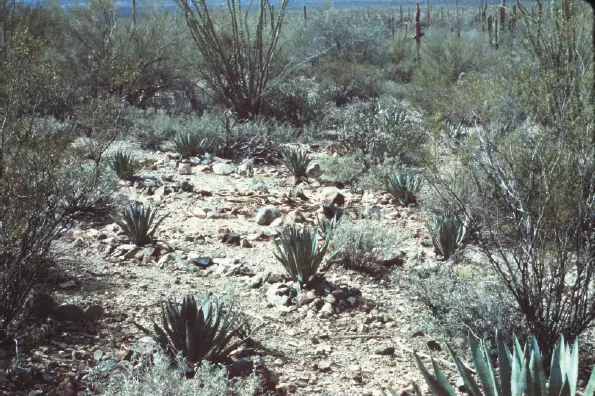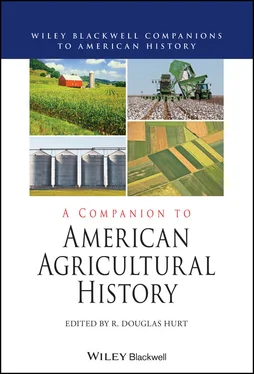Mitigation of cultural resources in the right-of-way of Interstate Highway 10 alongside the Santa Cruz River in the Tucson Basin revealed an astonishing cluster of deeply buried, early agricultural settlements dating between 2100 BCE and 100 CE, a time period called the Early Agricultural Period. Canal construction in the Tucson Basin began as early as 1500 BCE (Vint 2017). The site of Las Capas is remarkable due to its associated system of canals and rectangular fields, more than five acres (2 ha) of which were exposed by backhoes with 7-foot wide blades. By the first millennium BCE, an estimated 12.4 acres (5 ha) of land surrounding Las Capas might have been irrigated (Vint 2017).
Occupation of the Santa Cruz floodplain was not necessarily continuous throughout the entire 2000-year time frame called the Early Agricultural Period, and degree of sedentariness, even during stretches of optimal climate, is a topic debated by archaeologists (Roth 2016; Vint 2017). Faunal and floral remains reflect a pattern of logistic mobility that included the hunting and harvesting of wild resources, without evidence for significant pressure on either large or small animals. Maize is estimated to have contributed approximately 30 percent of caloric intake on an annual basis, with amaranth and other weedy plants encouraged in and near fields as supplemental foods (Vint 2017).
The Tucson Basin was not the only place in the Southwest where early farming communities practiced irrigation. Similarly ancient canals have been found at La Playa in northern Sonora, Mexico, and at a site dating to 1000 BCE near Zuni in western New Mexico (Damp, Hall, and Smith 2002; Hanselka 2017). Terraces ( trincheras ) built on hills in southern Arizona and northern Chihuahua demonstrate another form of organized communal labor. Cerro Juanaqueña is a prime example, with nearly 500 rock-lined earthen terraces covering the flanks and summit of a 140 m high basalt hill overlooking the fertile Casas Grandes river valley in Chihuahua. The major occupation at Cerro Juanaqueña dates to 1300–1100 BCE, with maize found in 69 percent of the features excavated (Hard et al. 2008). Terraces served as foundations for domestic structures and pits, with crops grown in the river valley below.
Firm evidence for domesticates other than maize in early components is surprisingly rare. Squash ( Cucurbita pepo ssp . pepo ) as old as 1700 BCE has been reported from McEuen Cave in the Gila Mountains of eastern Arizona, and fragments predating 500 BCE came from two sites—Sheep Camp Shelter and Bat Cave—in New Mexico (Hanselka 2017, table 15.2). Bottle gourd ( Lagenaria siceraria ) phytoliths were reported from field sediments at Las Capas (Vint 2017). Common beans ( Phaseolus vulgaris ) were apparently not grown by the earliest southwestern food producers, which is not surprising in light of the late initial domestication date for beans—c. 300 bce—in Mesoamerica (Kaplan and Lynch 1999).
By 450 CE, the culture known as Hohokam, which was based on intensive farming, developed in the Phoenix and Tucson basins and immediately surrounding areas. Maize was ubiquitous, as it had been previously, but additional crops had joined the system. These included common beans, lima beans ( Phaseolus lunatus ), and tepary beans ( Phaseolus acutifolius ). Teparies are supremely well adapted to Sonoran Desert aridity and were possibly domesticated north of the Mesoamerican culture area, in northwestern Mexico (Muñoz et al. 2006). Squash species grown along with Cucurbita pepo ssp. pepo include the cushaw squash ( C. argyrosperma ssp. argyrosperma ) and butternut squash ( C. moschata ). Cotton ( Gossypium hirsutum var. punctatum ) was an important Hohokam fiber crop, utilized locally and traded to regions where neither irrigation nor rainfall were adequate for meeting its moisture requirements (Adams and Fish 2011). Two species of cultigen amaranth— Amaranthus cruentus and A. hypochondriacus were grown for grain and probably other uses including edible green leaves (similar to spinach, mustard greens, collard greens) and dye (Fritz et al. 2009).
Agaves ( Agave spp.) are recognized as locally cultivated crops essential to the Hohokam economy (Adams and Fish 2011; Fish and Fish 2014; Hodgson, Salywon, and Doelle 2018). They were grown in rockpile fields that extended for kilometers along the lower slopes of bajadas , above irrigable river terraces but at lower elevations than where wild agave plants thrive without human care. Extensive rockpile-dotted landscapes yield tabular stone knives used for stripping leaves from agave hearts, and the fields include large roasting pits for baking the carbohydrate-rich hearts. Agaves were not only an important source of food, but their fibers were used for ropes and textiles, and drinks were likely made from the sugary juice in ancient times as they are still today. Wendy Hodgson and colleagues (2018) recognize seven extant species of agave in the Southwest as surviving examples of ancient domesticates. Most are rare today and found only in proximity to archaeological settlements and/or ancient rockpile fields (Figure 1.4).

Figure 1.4 Agave murpheyi growing in a cultivated rockpile field at the Arizona Sonora Desert Museum. Source: Photo by the author (Gayle Fritz), April 2002.
The Hohokam culture is justifiably called “one of the major irrigation societies in the ancient world” (Adams and Fish 2011). Canal construction began by 650 CE, with trunkline canals in the Phoenix Basin alone extending over 500 km in length. Canals connected irrigation communities that were integrated socially by ballcourts before c. 1150 CE, and later by platform mounds and adobe “great houses” such as the one preserved at Casa Grande National Monument. A high level of coordination anchored by experts with superb engineering and agronomic skills was required for construction and maintenance of canal systems of this magnitude.
Other forms of water management coexisted with canal irrigation. These included: (i) diversion of runoff from seasonal storms, sometimes using structures made of brush and earth; (ii) check dams; (iii) stone terraces; (iv) reservoirs; (v) stone or earthen grids for moisture retention; and (vi) rock mulches (Adams and Fish 2011). Wild and managed plants were always important foods, with some, such as mesquite pods, being stored along with crops. Many seeds from species of weedy plants probably reflect use of tolerated, encouraged, or cultivated resources that grew in and near formal fields.
Several crops native to the Sonoran Desert, in addition to agaves, seem to have been domesticated to some extent by ancient farmers in this region. Sonoran panic grass ( Panicum sonorum ), with large, pale grains and heavy panicles, was a notable floodplain crop formerly sown in receding floodwaters of the lower Colorado River by Yuman-speaking forager-farmers and still grown by Piman groups in Sonora, Mexico (Nabhan and DeWet 1984). Little barley ( Hordeum pusillum ) seeds show signs of selection for naked (hull-less) grains (Adams 2014). Devil’s claw ( Proboscidea parviflora ) was bred for longer, more pliable fibers, but not until a market for O’odham baskets arose in historic times (Nabhan et al. 1981). Cholla ( Cylindropuntia spp.) and Mexican crucillo ( Condalia warnockii var. kearneyana ) may also have been transplanted or otherwise cultivated, judging by archaeological distributions outside their known phytogeographic ranges (Bohrer 1991).
Читать дальше












